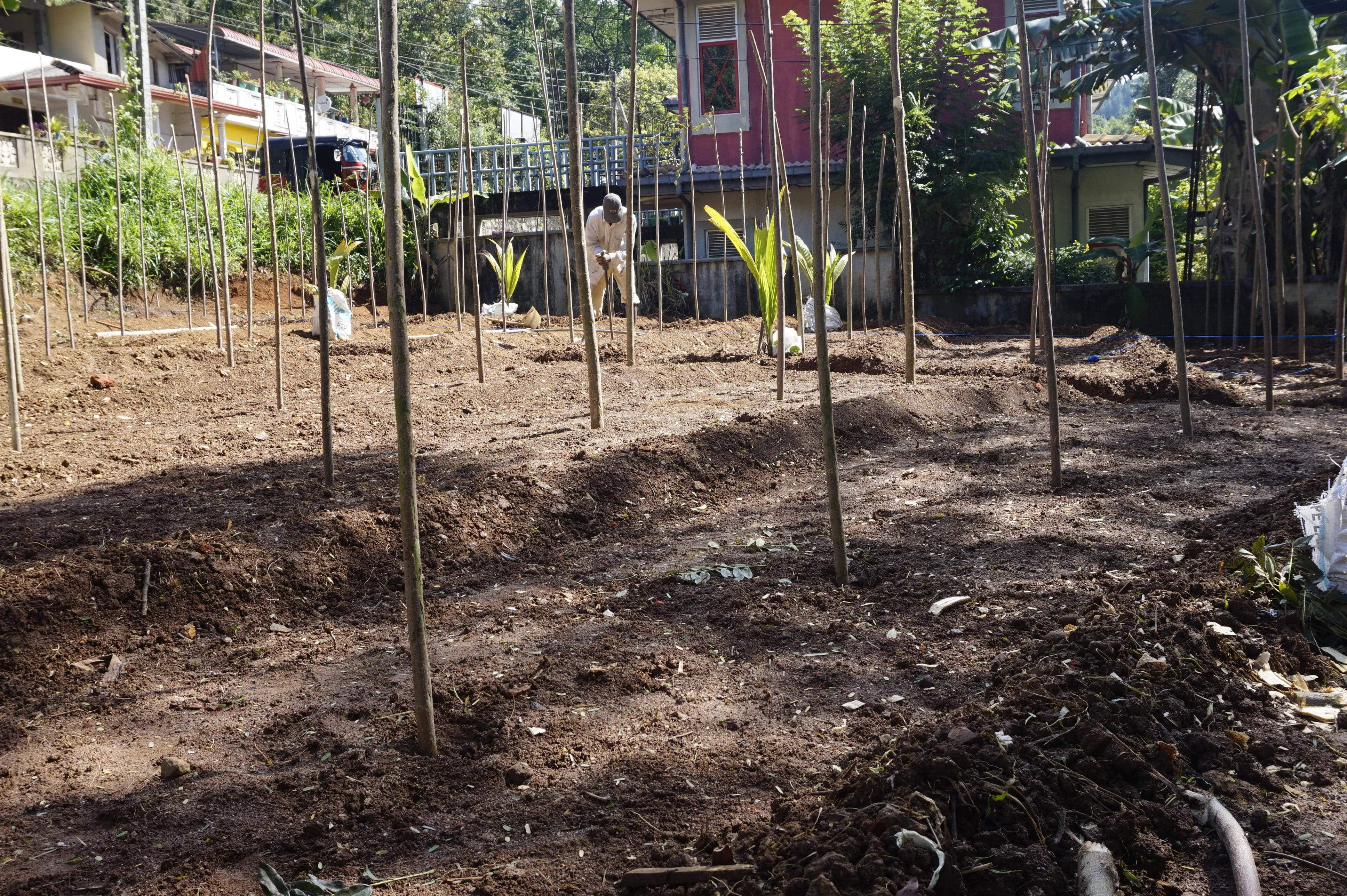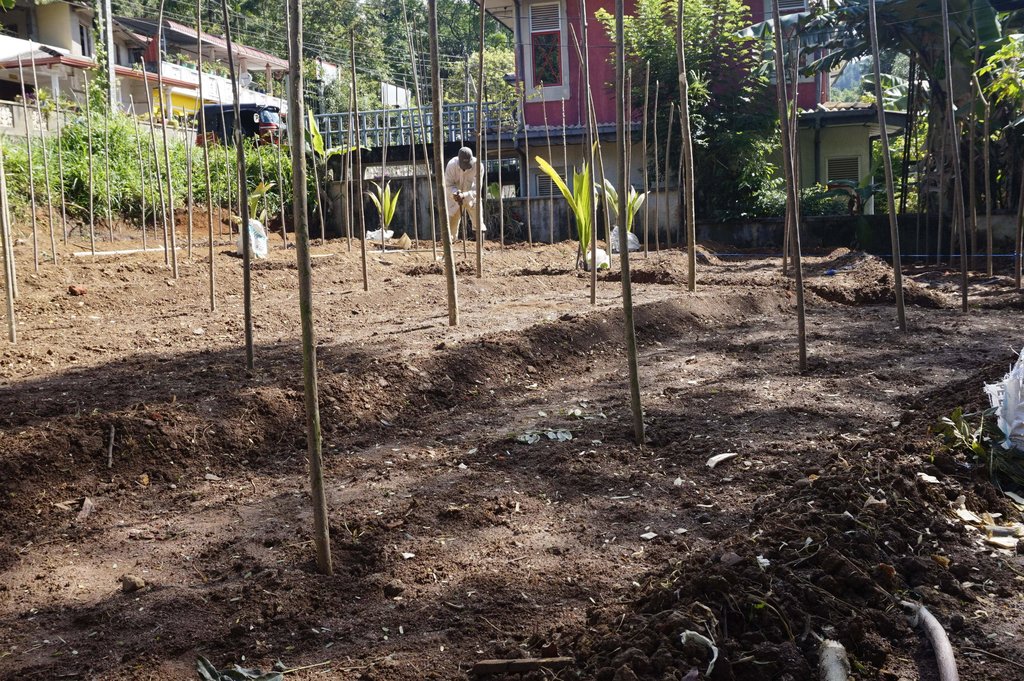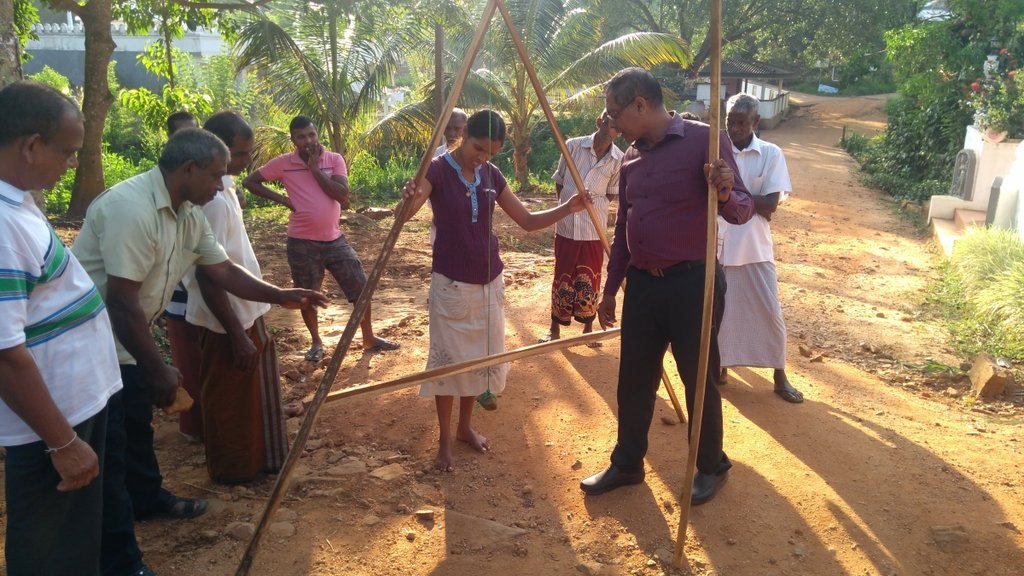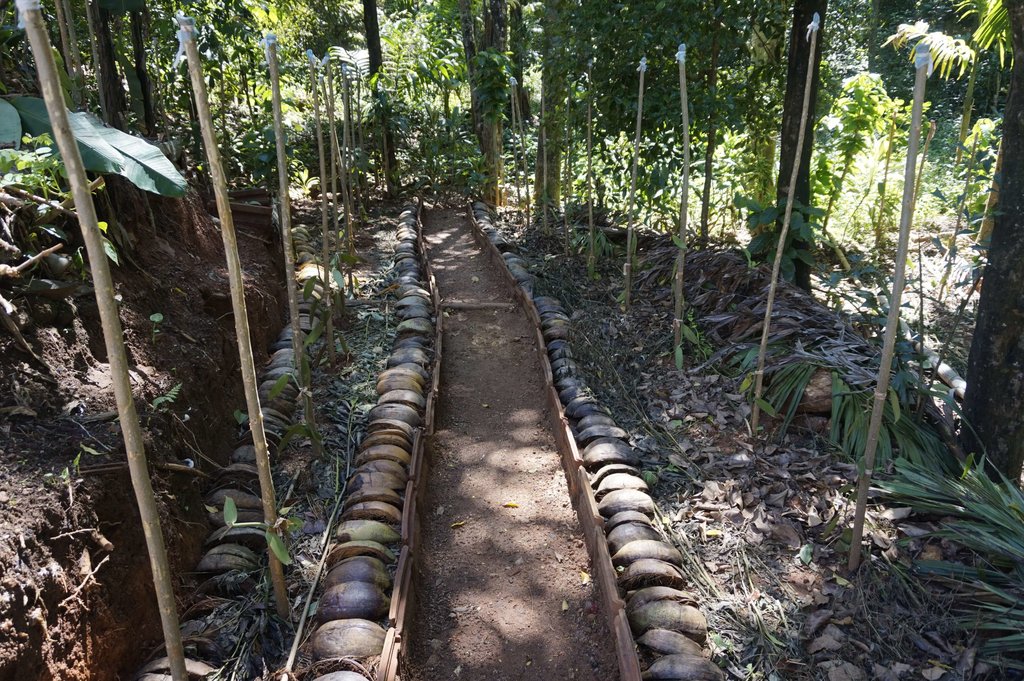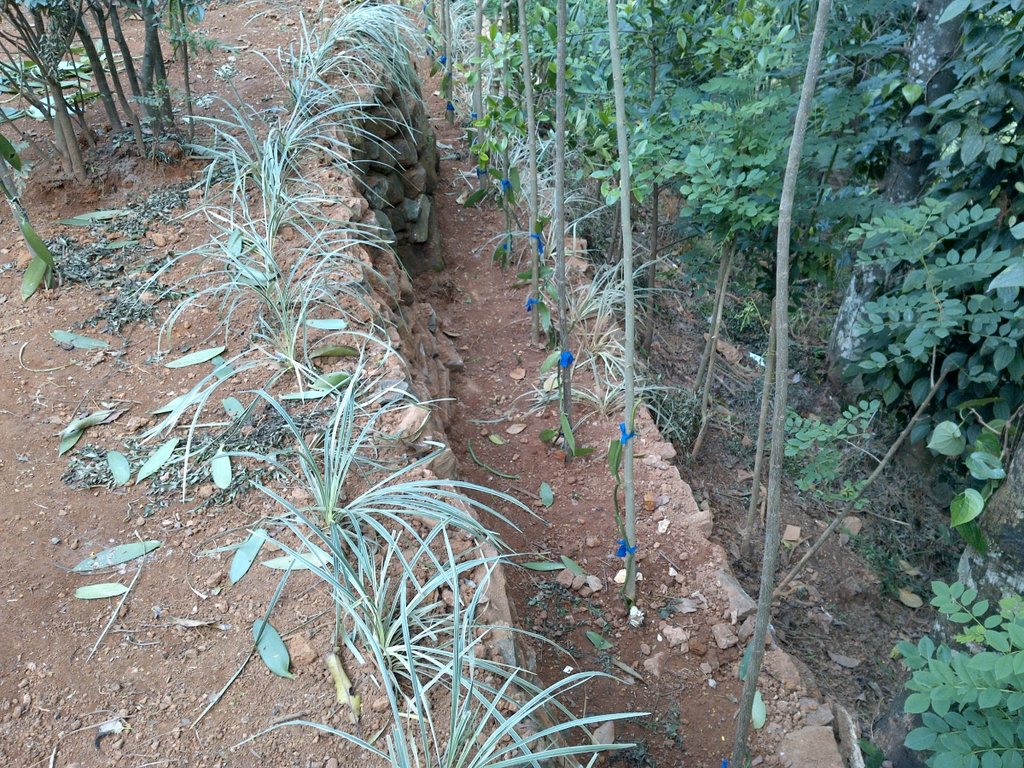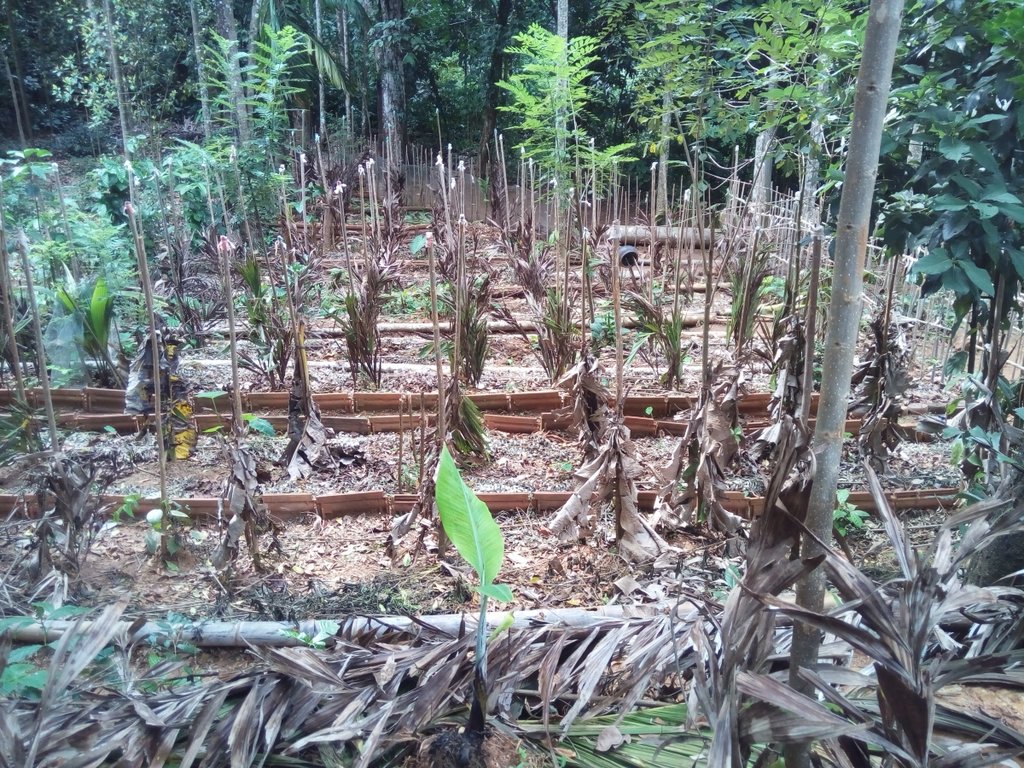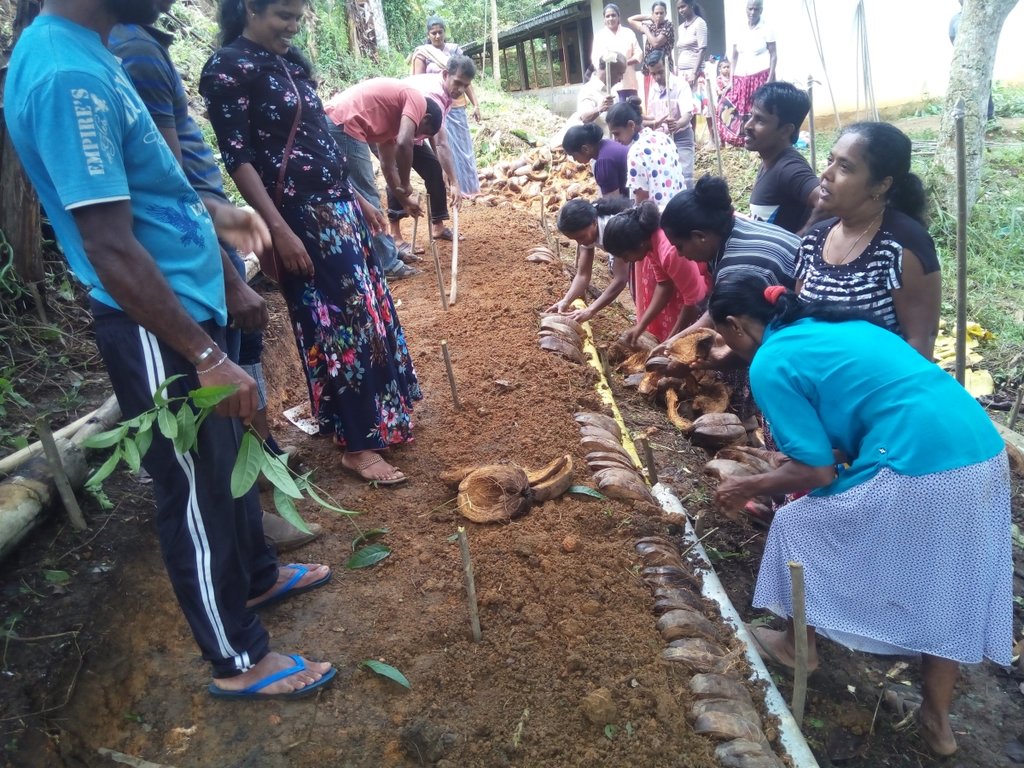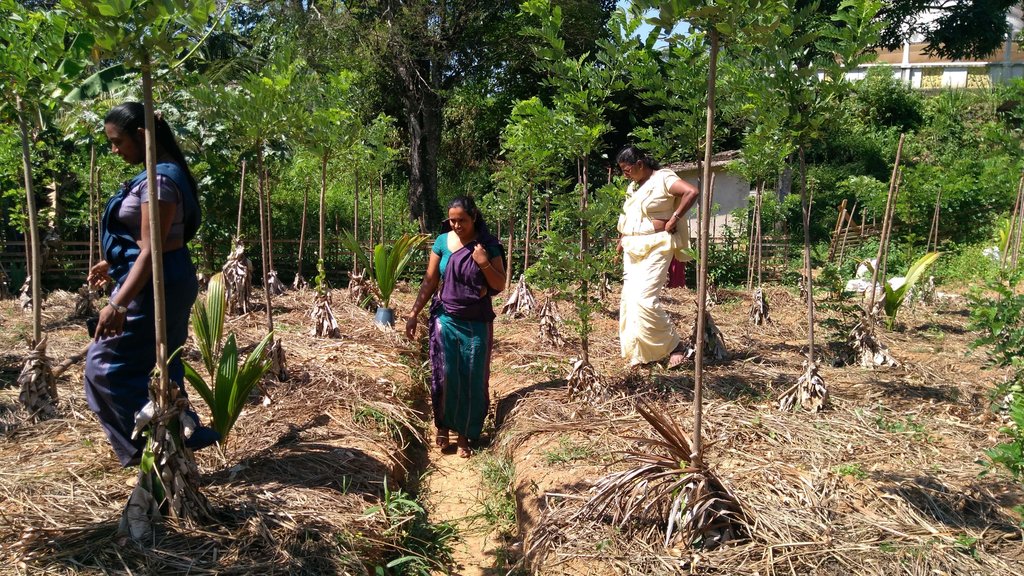Individual platforms and contour platforms [Sri Lanka]
- Creation:
- Update:
- Compiler: Bandara Rotawewa
- Editor: –
- Reviewers: Ursula Gaemperli, Rima Mekdaschi Studer
Thani wedika and samochcha wedika
technologies_5621 - Sri Lanka
View sections
Expand all Collapse all1. General information
1.2 Contact details of resource persons and institutions involved in the assessment and documentation of the Technology
Key resource person(s)
SLM specialist:
1.3 Conditions regarding the use of data documented through WOCAT
The compiler and key resource person(s) accept the conditions regarding the use of data documented through WOCAT:
Yes
1.4 Declaration on sustainability of the described Technology
Is the Technology described here problematic with regard to land degradation, so that it cannot be declared a sustainable land management technology?
No
1.5 Reference to Questionnaire(s) on SLM Approaches (documented using WOCAT)
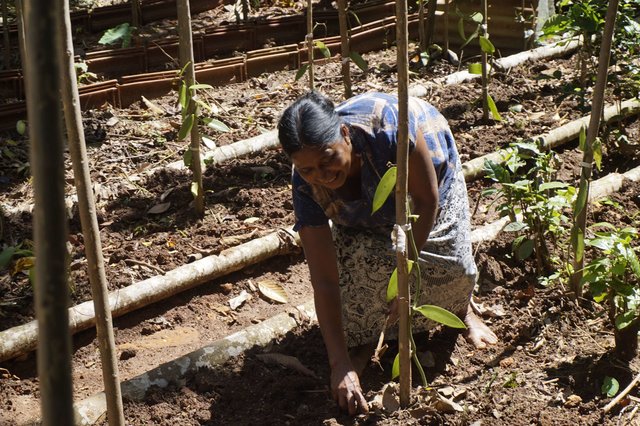
Women practices SLM through Vanilla cultivation [Sri Lanka]
Women in Central Highlands of Sri Lanka practice sustainable land management through vanilla cultivation and earn extra income for their families
- Compiler: Bandara Rotawewa
2. Description of the SLM Technology
2.1 Short description of the Technology
Definition of the Technology:
Construction of individual platforms or contour platforms to control soil erosion in the home gardens (HG) to cultivate vanilla as a cash crop
2.2 Detailed description of the Technology
Description:
Doluwa is located in the Central Highlands of Sri Lanka. This area belongs to the Wet zone mid-country agro-ecological region according to Sri Lankan classification. The elevation of the area is 575 meters. The mean temperature of the area is about 24 °C. The area receives rainfall from two monsoons. North-east monsoon rain comes from November to January with an annual rainfall of 1800 mm. The South-west monsoon rain lasts from May to September and contributes a major portion of the annual rainfall. February, March, and July months receive lower rainfall. The Central Highlands have excellent agro-ecological conditions for tea plantations, spice crops like cloves, nutmeg and cardamom, fruit crops such as avocado, durian, coffee, banana, and black pepper. Paddy cultivation is practiced in the valleys. Areas over 50% of slope inclination are covered by protected forests. The main livelihood activity is agriculture: mainly cultivation of tea, spices, and vegetables. About 43% of the land is under tea cultivation; and around 15% is marginalized or abandoned land, due to land degradation and low productivity of soils.
The average land size of home gardens in the Central Highlands of Sri Lanka is about 0.25 – 0.5 acres. Fruits and spice trees randomly exist in these land plots. The topsoil is always disturbed due to daily human activities. Apart from run-off water from upper lands, rooftop rainwater flows in all directions causing heavy soil erosion in these home gardens. The home gardens are the least attended land plots in terms of conservation due to low-income generation.
Traditionally, home gardens with randomly planted perennial trees are usually shady. Therefore, farm families generally believe that cultivation of cash crops in their home gardens is impossible. The introduction of Individual Platforms and Contour Platforms as a soil conservation methodology, piloted in the Doluwa area by an FAO project on Rehabilitation of Degraded Agricultural in several Districts of the Central Highlands of Sri Lanka has proven the contrary, as mainly vanilla is known as a shade-preferring crop. Furhter, vanilla is economically highly valuable and has the potential to generate good income. Consequently, adequate platforms (small soil terraces) were constructed and used for vanilla cultivation. Vanilla grows particularly well where the soil organic matter content is high. Organic matter required to enrich the soil can be collected directly from the home gardens (leaves and residues) and is also coming from organic kitchen waste. These organic residues are recycled into compost and finally used for the cultivation of vanilla. Additionally, mulching is practiced to control topsoil erosion. Each vanilla plant as a tropical climbing vine grows up a previously planted two-meter-high Gliricidia stick. Gliricidia serves on the one hand as a living fixing stick and provider of shade and, as a leguminous tree (Fabaceae family) the plant has the potential to fix nitrogen in the soil.
Construction of the platforms:
The individual platforms are constructed around the planting hole and are one meter wide and two meters in length. The distance between the two platforms is the same (minimum 2 meters) as the space for the vanilla plant. The lower side of the platform (lower edge) has a shoulder bund, stabilized with coconut husk, tree logs, and stones.
The contour platforms are 1.75 meters in width and length depending on the land size and other characteristics. The platform is constructed with a slightly inverted gradient. A small drain with a suitable gradient along the length on the upper side of the platform is constructed to drain out excess water during rain. These small drains are connected to a leader drain. The edges of the platforms are well stabilized again by coconut husk, tree logs or stones (shoulder bund measure: height x width = 20cm x 30cm).
This sustainable land management (SLM) technology is highly accepted by the farm families, as the Vanilla SLM model is an economically attractive opportunity especially for women; but only where the environmental conditions are suitable for vanilla growing.
2.3 Photos of the Technology
2.5 Country/ region/ locations where the Technology has been applied and which are covered by this assessment
Country:
Sri Lanka
Region/ State/ Province:
Central
Further specification of location:
Doluwa
Specify the spread of the Technology:
- applied at specific points/ concentrated on a small area
Is/are the technology site(s) located in a permanently protected area?
No
2.6 Date of implementation
Indicate year of implementation:
2018
If precise year is not known, indicate approximate date:
- less than 10 years ago (recently)
2.7 Introduction of the Technology
Specify how the Technology was introduced:
- through projects/ external interventions
Comments (type of project, etc.):
Rehabilitation of Degraded Agricultural Lands in Kandy, Badulla and Nuwara Eliya Districts in the Central Highlands of Sri Lanka
3. Classification of the SLM Technology
3.1 Main purpose(s) of the Technology
- improve production
- reduce, prevent, restore land degradation
- protect a watershed/ downstream areas – in combination with other Technologies
- create beneficial economic impact
3.2 Current land use type(s) where the Technology is applied
Land use mixed within the same land unit:
Yes
Specify mixed land use (crops/ grazing/ trees):
- Agroforestry

Cropland
- Annual cropping
- Tree and shrub cropping
- Vanilla
Comments:
Crop types commonly found in these home gardens are cloves, nutmeg and cardamom, fruit crops of avocado, durian, coffee, banana, and black pepper
3.3 Has land use changed due to the implementation of the Technology?
Land use mixed within the same land unit:
No
3.4 Water supply
Water supply for the land on which the Technology is applied:
- rainfed
3.5 SLM group to which the Technology belongs
- cross-slope measure
- home gardens
3.6 SLM measures comprising the Technology

agronomic measures
- A2: Organic matter/ soil fertility

structural measures
- S1: Terraces
3.7 Main types of land degradation addressed by the Technology

soil erosion by water
- Wt: loss of topsoil/ surface erosion
- Wg: gully erosion/ gullying
3.8 Prevention, reduction, or restoration of land degradation
Specify the goal of the Technology with regard to land degradation:
- prevent land degradation
- reduce land degradation
4. Technical specifications, implementation activities, inputs, and costs
4.1 Technical drawing of the Technology
Technical specifications (related to technical drawing):
Slope gradient in home gardens before introduction of the SLM Technology.
Author:
Bandara Rotawewa
Date:
05/04/2020
Technical specifications (related to technical drawing):
Contour platforms: the ideal platform is 175 cm wide. The length is depending on the available length of the land. The platform is constructed by cutting the upper section and fill in to the lower section to get an inverse slope of 5 to 10%. The shoulder bund is 30 cm wide and 20 cm height. The shoulder bund is protected with coconut husk/ timber logs etc.
Individual platform: The spacing between the two plants in the platforms is 1 - 1.5 meters. The individual platform size can be 100 cm wide and 200 cm in length. Coconut husks, stones, timber logs can be used to protect the edges of the platform.
Author:
Bandara Rotawewa
Date:
05/04/2020
Technical specifications (related to technical drawing):
Technical description: dito drawing 2.
Author:
Bandara Rotawewa
Date:
05/04/2020
4.2 General information regarding the calculation of inputs and costs
Specify how costs and inputs were calculated:
- per Technology area
Indicate size and area unit:
0.25 acre
Specify currency used for cost calculations:
- USD
Indicate average wage cost of hired labour per day:
840 USD per 1/4 acre of land
4.3 Establishment activities
| Activity | Timing (season) | |
|---|---|---|
| 1. | Construction of contour or individual platform terraces | Before establishment of the crop |
| 2. | Reinforcement of the shoulder bunds with coconut husk/ tree logs/ etc | After construction of contour platform or individual platforms |
| 3. | Preparing of compost and mixing it into the top soil | Before establishment of the crop |
| 4. | Planting of vanilla rooted cutting | First Live Gliricidia sticks are planted. After they rooted, vanilla cuttings are planted) |
4.4 Costs and inputs needed for establishment
| Specify input | Unit | Quantity | Costs per Unit | Total costs per input | % of costs borne by land users | |
|---|---|---|---|---|---|---|
| Labour | Construction of contour platforms in a quarter of Acre | person days | 40.0 | 15.0 | 600.0 | 100.0 |
| Labour | Planting of vanilla rooted cutting | person days | 1.0 | 15.0 | 15.0 | 100.0 |
| Plant material | Gliricidia sticks | number | 200.0 | 0.2 | 40.0 | 100.0 |
| Plant material | Vanilla rooted cuttings | number | 200.0 | 0.4 | 80.0 | |
| Fertilizers and biocides | Preparing of compost and mixing it into the top soil | person days | 5.0 | 15.0 | 75.0 | 100.0 |
| Construction material | Coconut husk/ tree logs | pieces | 4005.0 | 0.03 | 120.15 | 100.0 |
| Total costs for establishment of the Technology | 930.15 | |||||
| Total costs for establishment of the Technology in USD | 930.15 | |||||
If land user bore less than 100% of costs, indicate who covered the remaining costs:
The project on Rehabilitation of Degraded Agriculture Lands implemented by Food and Agriculture Organization of the United Nations and funded by Global Environmental Facility
4.5 Maintenance/ recurrent activities
| Activity | Timing/ frequency | |
|---|---|---|
| 1. | Removal of overgrown grass and trimming of grass on the shoulder bunds | Twice a year (after the rainy season) |
| 2. | Repair of the broken places of the terrace, shoulder bunds etc | Once a year |
4.6 Costs and inputs needed for maintenance/ recurrent activities (per year)
| Specify input | Unit | Quantity | Costs per Unit | Total costs per input | % of costs borne by land users | |
|---|---|---|---|---|---|---|
| Labour | Removal of overgrown grass and trimming of grass on the shoulder bunds | Person days | 5.0 | 15.0 | 75.0 | 100.0 |
| Labour | Repair of the broken places of the terrace, shoulder bunds etc | Person days | 3.0 | 15.0 | 45.0 | 100.0 |
| Total costs for maintenance of the Technology | 120.0 | |||||
| Total costs for maintenance of the Technology in USD | 120.0 | |||||
4.7 Most important factors affecting the costs
Describe the most determinate factors affecting the costs:
Steepness of the slope is greatly determining the labour cost requirement for the construction of individual platforms and contour platforms. The cost of coconut husk is another cost component for conservation.
Maintenance is mostly depending on ground grass cover and periodical maintenance.
5. Natural and human environment
5.1 Climate
Annual rainfall
- < 250 mm
- 251-500 mm
- 501-750 mm
- 751-1,000 mm
- 1,001-1,500 mm
- 1,501-2,000 mm
- 2,001-3,000 mm
- 3,001-4,000 mm
- > 4,000 mm
Specify average annual rainfall (if known), in mm:
2500.00
Specifications/ comments on rainfall:
Two monsoons: North-East monsoon is from November to December with an average monthly RF of 80 – 100 mm. Southwest monsoon is from April to July with an average RF of 108 – 200. First Inter monsoon is from January to March is with 180 – 200 mm RF while second inter monsoon with 300 – 350 mm of RF. February is the driest month of a year.
The minimum mean temperature is 200 Celsius and the maximum mean temperature is 240 Celsius and the annual mean temperature is 240 Celsius.
Agro-climatic zone
- humid
5.2 Topography
Slopes on average:
- flat (0-2%)
- gentle (3-5%)
- moderate (6-10%)
- rolling (11-15%)
- hilly (16-30%)
- steep (31-60%)
- very steep (>60%)
Landforms:
- plateau/plains
- ridges
- mountain slopes
- hill slopes
- footslopes
- valley floors
Altitudinal zone:
- 0-100 m a.s.l.
- 101-500 m a.s.l.
- 501-1,000 m a.s.l.
- 1,001-1,500 m a.s.l.
- 1,501-2,000 m a.s.l.
- 2,001-2,500 m a.s.l.
- 2,501-3,000 m a.s.l.
- 3,001-4,000 m a.s.l.
- > 4,000 m a.s.l.
Indicate if the Technology is specifically applied in:
- not relevant
5.3 Soils
Soil depth on average:
- very shallow (0-20 cm)
- shallow (21-50 cm)
- moderately deep (51-80 cm)
- deep (81-120 cm)
- very deep (> 120 cm)
Soil texture (topsoil):
- medium (loamy, silty)
Soil texture (> 20 cm below surface):
- medium (loamy, silty)
Topsoil organic matter:
- low (<1%)
5.4 Water availability and quality
Ground water table:
5-50 m
Availability of surface water:
medium
Water quality (untreated):
poor drinking water (treatment required)
Water quality refers to:
both ground and surface water
Is water salinity a problem?
No
Is flooding of the area occurring?
No
5.5 Biodiversity
Species diversity:
- medium
Habitat diversity:
- medium
5.6 Characteristics of land users applying the Technology
Sedentary or nomadic:
- Sedentary
Market orientation of production system:
- mixed (subsistence/ commercial)
Relative level of wealth:
- poor
Individuals or groups:
- groups/ community
Level of mechanization:
- manual work
Gender:
- women
Age of land users:
- middle-aged
5.7 Average area of land used by land users applying the Technology
- < 0.5 ha
- 0.5-1 ha
- 1-2 ha
- 2-5 ha
- 5-15 ha
- 15-50 ha
- 50-100 ha
- 100-500 ha
- 500-1,000 ha
- 1,000-10,000 ha
- > 10,000 ha
Is this considered small-, medium- or large-scale (referring to local context)?
- small-scale
Comments:
Home gardens
5.8 Land ownership, land use rights, and water use rights
Land ownership:
- individual, titled
Land use rights:
- individual
Water use rights:
- individual
Are land use rights based on a traditional legal system?
Yes
5.9 Access to services and infrastructure
health:
- poor
- moderate
- good
education:
- poor
- moderate
- good
technical assistance:
- poor
- moderate
- good
employment (e.g. off-farm):
- poor
- moderate
- good
markets:
- poor
- moderate
- good
energy:
- poor
- moderate
- good
roads and transport:
- poor
- moderate
- good
drinking water and sanitation:
- poor
- moderate
- good
financial services:
- poor
- moderate
- good
6. Impacts and concluding statements
6.1 On-site impacts the Technology has shown
Socio-economic impacts
Production
crop production
Comments/ specify:
Before introducing the technology women did not think of vanilla cultivation. With technology, women realized vanilla as a cash crop, its potential for livelihood improvement.
crop quality
Comments/ specify:
Before introduction of the technology, vanilla growing suffered from soil erosion and poor soil quality
risk of production failure
land management
Water availability and quality
drinking water quality
Income and costs
farm income
diversity of income sources
economic disparities
workload
Socio-cultural impacts
food security/ self-sufficiency
community institutions
Comments/ specify:
Women were formed as a group for training arrangements, and for marketing purposes.
SLM/ land degradation knowledge
Comments/ specify:
The project provided practical training on SLM.
Ecological impacts
Water cycle/ runoff
water quality
Comments/ specify:
Reduced soil erosion made this possible
surface runoff
Comments/ specify:
contour platforms reinforced with coconut husk and tree logs reduce the runoff speed and quantity.
Soil
soil moisture
Comments/ specify:
reduced run off and increased organic matter content.
soil loss
soil organic matter/ below ground C
Comments/ specify:
Addition of compost increased the soil carbon content.
6.2 Off-site impacts the Technology has shown
downstream siltation
Comments/ specify:
this happened as a result of reduced runoff
groundwater/ river pollution
Comments/ specify:
this happened as a result of reduced runoff
damage on neighbours' fields
Comments/ specify:
this happened as a result of reduced runoff
6.3 Exposure and sensitivity of the Technology to gradual climate change and climate-related extremes/ disasters (as perceived by land users)
Gradual climate change
Gradual climate change
| Season | increase or decrease | How does the Technology cope with it? | |
|---|---|---|---|
| seasonal temperature | dry season | decrease | moderately |
Climate-related extremes (disasters)
Climatological disasters
| How does the Technology cope with it? | |
|---|---|
| drought | moderately |
6.4 Cost-benefit analysis
How do the benefits compare with the establishment costs (from land users’ perspective)?
{'template': 'raw', 'additional_translations': {}, 'key': 'Short-term returns', 'values': ['positive']}Long-term returns:
positive
How do the benefits compare with the maintenance/ recurrent costs (from land users' perspective)?
Short-term returns:
positive
Long-term returns:
positive
6.5 Adoption of the Technology
- > 50%
Of all those who have adopted the Technology, how many did so spontaneously, i.e. without receiving any material incentives/ payments?
- 11-50%
6.6 Adaptation
Has the Technology been modified recently to adapt to changing conditions?
No
6.7 Strengths/ advantages/ opportunities of the Technology
| Strengths/ advantages/ opportunities in the land user’s view |
|---|
| The home gardens that were unproductive is now used for income generation |
| The aesthetic view of the land increased |
| Simple technology |
| Low cost and affordable |
| Strengths/ advantages/ opportunities in the compiler’s or other key resource person’s view |
|---|
| Land unit production is increased |
| Farmers gained knowledge in sustainable land management techniques such as use of A – Frame for contour marking. |
| Use of kitchen waste and other vegetative materials for composting is increased |
| Conserve top soil moisture and reduce soil erosion |
6.8 Weaknesses/ disadvantages/ risks of the Technology and ways of overcoming them
| Weaknesses/ disadvantages/ risks in the land user’s view | How can they be overcome? |
|---|---|
| 1)The contour terraces may damage by thunderstorm | Enforcement of edges of the (contour/individual) platforms with coconut husk, timer logs and establish leader drains |
| Weaknesses/ disadvantages/ risks in the compiler’s or other key resource person’s view | How can they be overcome? |
|---|---|
| The farmers’ awareness of technology and its’ impact is low. Therefore, adaptation/dissemination is low. | Farmer motivation and exposure visits are essential activities |
7. References and links
7.1 Methods/ sources of information
- field visits, field surveys
- interviews with land users
- interviews with SLM specialists/ experts
When were the data compiled (in the field)?
15/06/2019
7.2 References to available publications
Title, author, year, ISBN:
Women practice SLM through Vanilla cultivation [Sri Lanka]
Available from where? Costs?
No cost
7.3 Links to relevant online information
Title/ description:
WOCAT Approach
URL:
https://qcat.wocat.net/en/wocat/approaches/view/approaches_5177/
7.4 General comments
Easy to complete the technology.
Links and modules
Expand all Collapse allLinks

Women practices SLM through Vanilla cultivation [Sri Lanka]
Women in Central Highlands of Sri Lanka practice sustainable land management through vanilla cultivation and earn extra income for their families
- Compiler: Bandara Rotawewa
Modules
No modules


